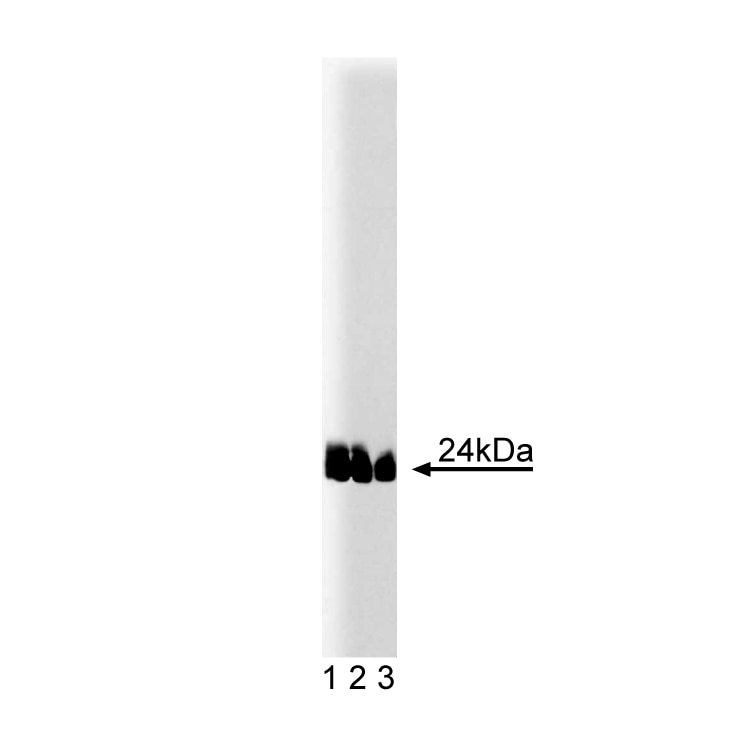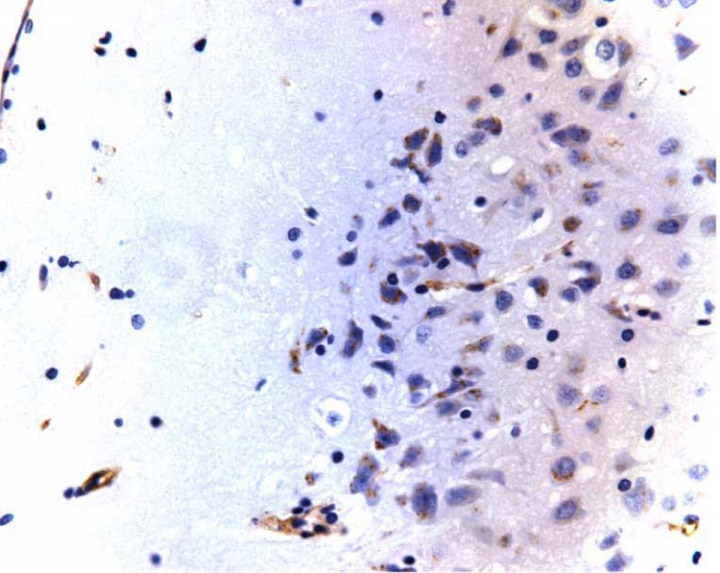Old Browser
Looks like you're visiting us from United States.
Would you like to stay on the current country site or be switched to your country?
BD Transduction Laboratories™ Purified Mouse Anti- Caveolin-1 (pY14)
克隆 56/Caveolin (pY14) (RUO)




Western blot analysis of caveolin-1 (pY14) on lysates from A431 cells (Human epithelial carcinoma; ATCC CRL-1555) treated with 100 ng/mL EGF. Lane 1: 1:1000, lane 2: 1:2000, lane 3: 1:4000 dilution of the mouse anti- caveolin-1 (pY14) antibody.

Immunohistochemistry: Zinc-fixed paraffin-embedded rat brain section stained with the mouse anti- caveolin-1 (pY14) antibody (40X magnification).


BD Transduction Laboratories™ Purified Mouse Anti- Caveolin-1 (pY14)

BD Transduction Laboratories™ Purified Mouse Anti- Caveolin-1 (pY14)

监管状态图例
未经BD明确书面授权,严禁使用未经许可的任何商品。
准备和存储
推荐的实验流程
Western blot: Please refer to http://www.bdbiosciences.com/pharmingen/protocols/Western_Blotting.shtml
商品通知
- Since applications vary, each investigator should titrate the reagent to obtain optimal results.
- Source of all serum proteins is from USDA inspected abattoirs located in the United States.
- Caution: Sodium azide yields highly toxic hydrazoic acid under acidic conditions. Dilute azide compounds in running water before discarding to avoid accumulation of potentially explosive deposits in plumbing.
- Please refer to www.bdbiosciences.com/us/s/resources for technical protocols.
Caveolin (VIP21) localizes to non-clathrin membrane invaginations (caveolae) on the inner surface of the plasma membrane. In addition, it is present in the trans-Golgi network (TGN) and in apically and basolaterally destined transport vesicles. Caveolin is a transmembrane adaptor molecule that recognizes GPI-linked proteins and interacts with downstream cytoplasmic signaling molecules, such as src-family tyrosine kinases and hetero-trimeric G proteins. Caveolin forms large lipid-binding oligomers, which are thought to play a role in caveolae formation. It may also function as a scaffolding protein, which organizes signaling molecules. This functional role is supported by the fact that caveolin interacts directly with inactive ras and G-protein α subunits. Phosphorylation of caveolin at Tyr-14, Ser-88, and other residues in v-src transformed cells leads to flattening, aggregation, and fusion of caveolae and caveolae-derived vesicles. Thus, caveolin is the principle protein of caveolae and may be involved in v-src mediated cellular transformation.
This antibody has also been reported to cross-react to paxillin in mouse embryonic fibroblasts (MEF), observable to migrate at ~ 68 kDa .
研发参考 (6)
-
Glenney JR, Soppet D. Sequence and expression of caveolin, a protein component of caveolae plasma membrane domains phosphorylated on tyrosine in Rous sarcoma virus-transformed fibroblasts. Proc Natl Acad Sci U S A. 1992; 89(21):10517-10521. (Biology). 查看参考
-
Hill M, Scherbakov N, Schiefermeier N, et al. Reassessing the role of phosphocaveolin-1 in cell adhesion and migration. Traffic. 2007; 8:1695-1705. (Clone-specific).
-
Labrecque L, Royal I, Surprenant DS, Patterson C, Gingras D, Béliveau R. Regulation of vascular endothelial growth factor receptor-2 activity by caveolin-1 and plasma membrane cholesterol. Mol Biol Cell. 2003; 14(1):334-347. (Biology: Western blot). 查看参考
-
Lee H, Volonte D, Galbiati F, et al. Constitutive and growth factor-regulated phosphorylation of caveolin-1 occurs at the same site (Tyr-14) in vivo: identification of a c-Src/Cav-1/Grb7 signaling cassette. Mol Endocrinol. 2000; 14(11):1750-1775. (Biology: Immunofluorescence, Western blot). 查看参考
-
Ushio-Fukai M, Hilenski L, Santanam N, et al. Cholesterol depletion inhibits epidermal growth factor receptor transactivation by angiotensin II in vascular smooth muscle cells: role of cholesterol-rich microdomains and focal adhesions in angiotensin II signaling. J Biol Chem. 2001; 276(51):48269-48275. (Biology: Immunofluorescence, Western blot). 查看参考
-
Volonté D, Galbiati F, Pestell RG, Lisanti MP. Cellular stress induces the tyrosine phosphorylation of caveolin-1 (Tyr(14)) via activation of p38 mitogen-activated protein kinase and c-Src kinase. Evidence for caveolae, the actin cytoskeleton, and focal adhesions as mechanical sensors of osmotic stress. J Biol Chem. 2001; 276(11):8094-8103. (Biology: Immunofluorescence, Western blot). 查看参考
Please refer to Support Documents for Quality Certificates
Global - Refer to manufacturer's instructions for use and related User Manuals and Technical data sheets before using this products as described
Comparisons, where applicable, are made against older BD Technology, manual methods or are general performance claims. Comparisons are not made against non-BD technologies, unless otherwise noted.
For Research Use Only. Not for use in diagnostic or therapeutic procedures.

